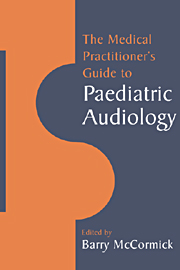Book contents
- Frontmatter
- Contents
- List of contributors
- Preface
- Acknowledgement
- 1 Introduction to hearing problems in childhood
- 2 Causes of deafness
- 3 Behavioural tests
- 4 Pure tone audiometry
- 5 Objective hearing tests
- 6 Middle-ear measurements
- 7 The management of otitis media with effusion
- 8 Management of unilateral hearing loss
- 9 Management of sensorineural hearing loss
- 10 Cochlear implants
- Index
4 - Pure tone audiometry
Published online by Cambridge University Press: 01 October 2009
- Frontmatter
- Contents
- List of contributors
- Preface
- Acknowledgement
- 1 Introduction to hearing problems in childhood
- 2 Causes of deafness
- 3 Behavioural tests
- 4 Pure tone audiometry
- 5 Objective hearing tests
- 6 Middle-ear measurements
- 7 The management of otitis media with effusion
- 8 Management of unilateral hearing loss
- 9 Management of sensorineural hearing loss
- 10 Cochlear implants
- Index
Summary
Introduction
Pure tone audiometry is the most commonly used procedure for the measurement of hearing loss in older children and adults. Pure tone signals (i.e. tones with a single frequency of vibration) are delivered to the patient via headphones or a bone vibrator. The patient's threshold of hearing at each frequency of interest is measured using a standard technique and the thresholds compared with normal values in order to quantify the degree of hearing loss. In addition comparison of airconduction and bone-conduction thresholds (the air–bone gap) can often give useful information about the type of hearing loss.
This chapter describes the equipment and techniques used to obtain pure tone audiograms with particular reference to the modifications necessary for paediatric work. It also describes the interpretation of audiograms and the limitations of the technique.
The audiometer
Audiometers range from simple screening instruments with a limited range of test frequencies and intensities to complex diagnostic instruments with facilities for a wide range of clinical tests in addition to threshold measurement. Signals may be presented via headphones (air conduction) or via a bone vibrator (bone conduction).
Frequency
The frequencies of interest are in the range 125 to 8000 Hz at octave intervals (an octave corresponds to a doubling of the frequency range),
i.e.
125,250, 500,1000,2000,4000, 8000 Hz
The following intermediate frequencies may also be of interest:
750,1500, 3000, 6000
Typically, in paediatric work, thresholds would be obtained for the frequency range 500-4000 Hz and other frequencies tested as necessary.
Information
- Type
- Chapter
- Information
- The Medical Practitioner's Guide to Paediatric Audiology , pp. 31 - 48Publisher: Cambridge University PressPrint publication year: 1995
